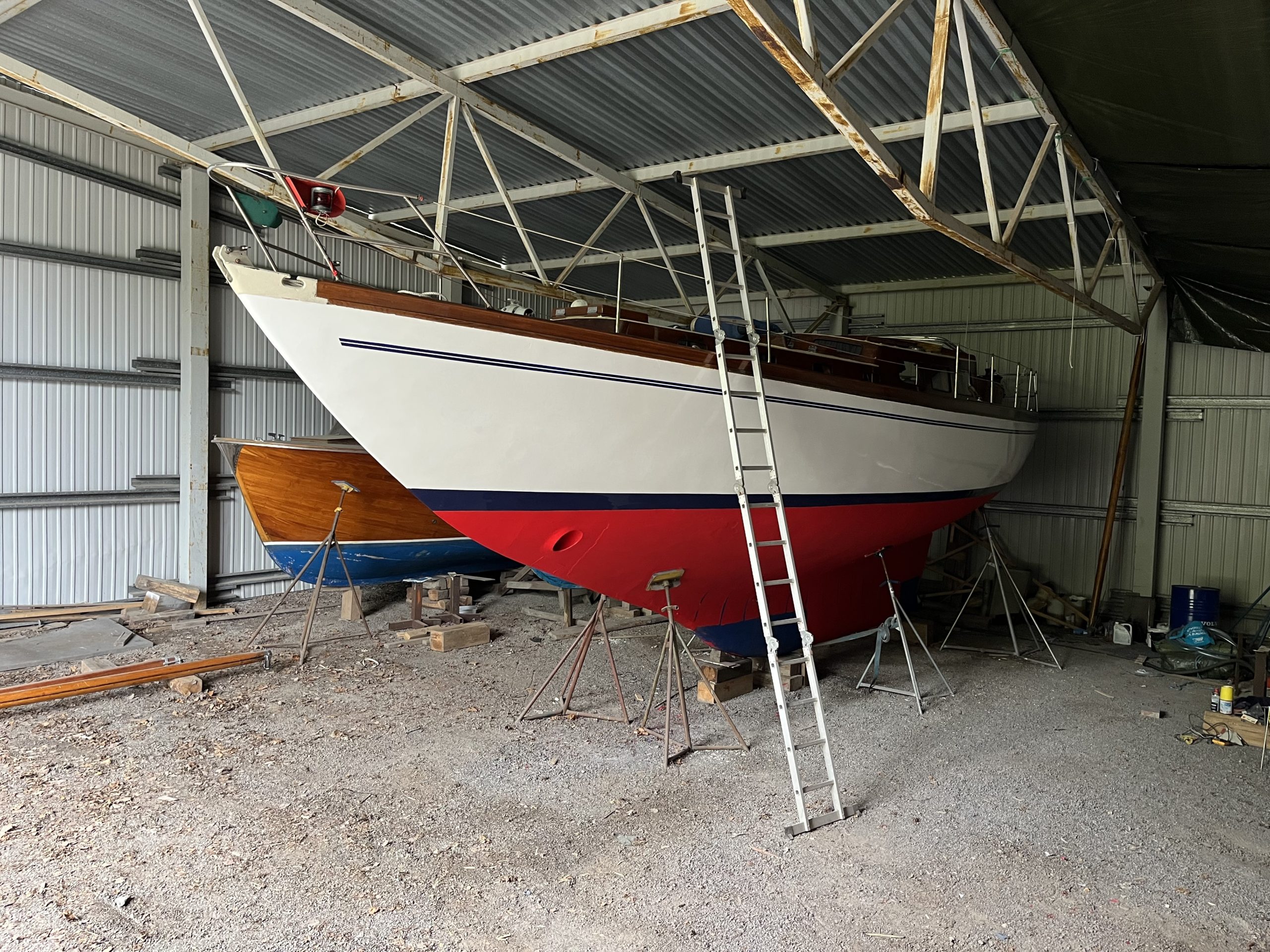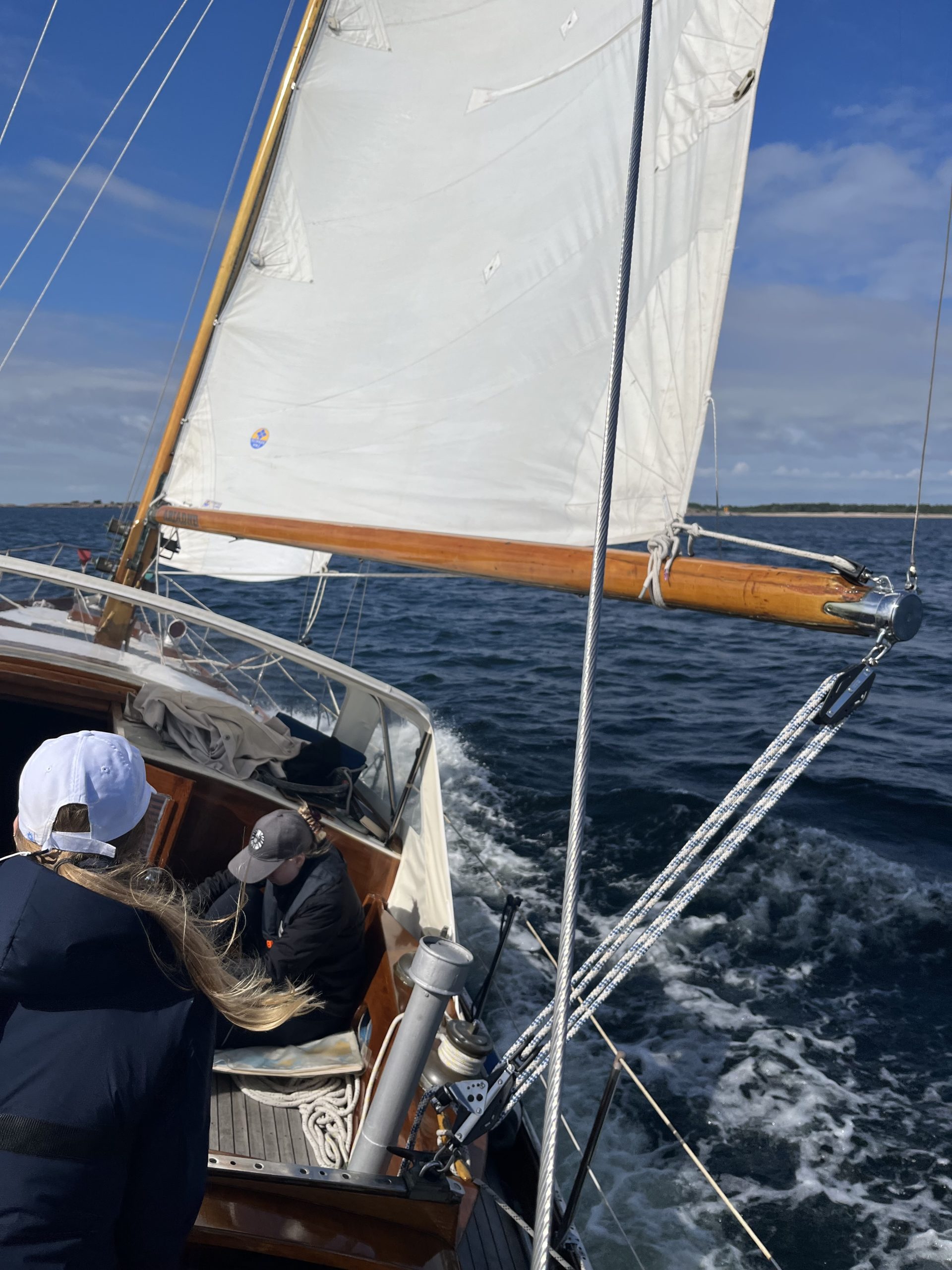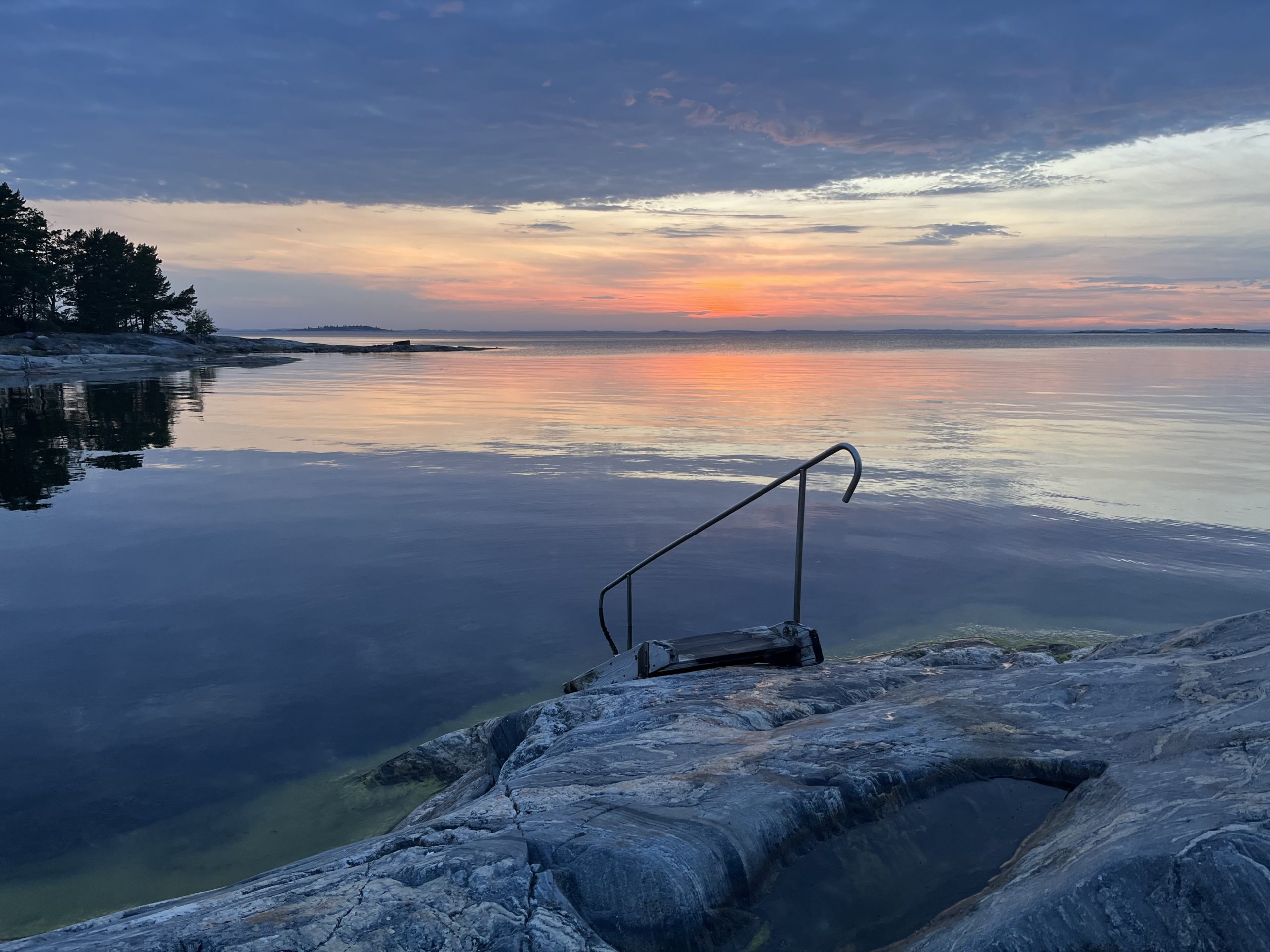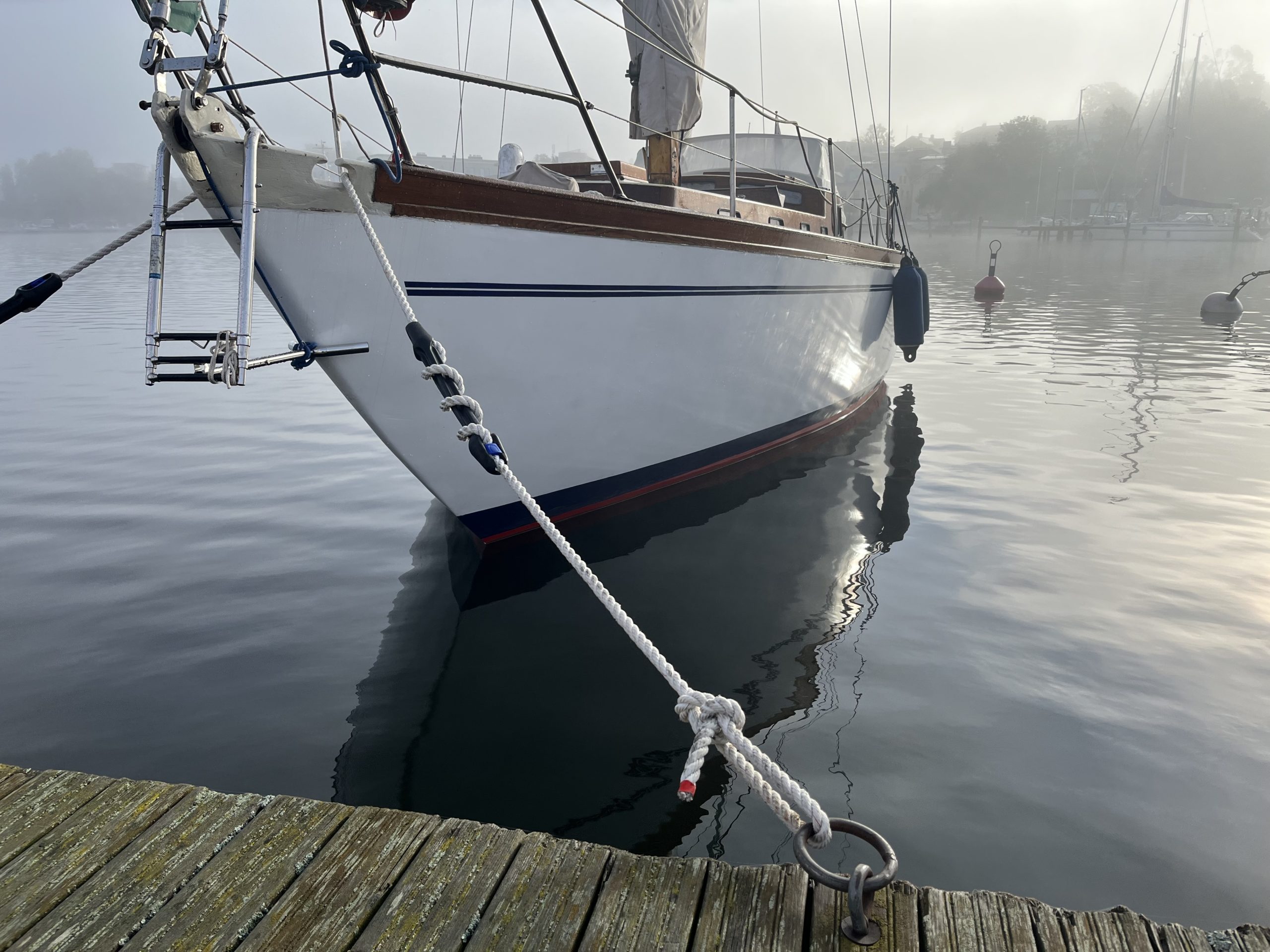Mainly just messing around
This year’s Ariadne’s summer story is mostly about getting ready to sail, you only get to sail at the end, so if that’s all you’re interested in, you should go to On the move.
During the winter, the most memorable Ariadne events of the previous summer were always brought back to mind. Many of them involved mooring or detaching from the pier when the wind was brisk. Especially when starting from the home harbor in a lively easterly crosswind, one step could be to reverse completely away from the pole position, throw the rope loop to the windward pole and wait for the wind to turn the ship’s bow in the direction of travel, i.e. out of the harbor. This method started to be a fairly standard way of leaving Inko harbor when there was a brisk northeast or east wind, i.e. when the wind was blowing from the side. From time to time it had occurred to me how to turn its bow more easily in the desired direction, because Ariadne, especially with Pak, does not turn anywhere much and if it does, the direction is wrong. The answer was always haunted by the bow thruster making a noise similar to the sound of a chainsaw in the boat. As a result of a few conversations on social media and thinking at night, I had researched bow thruster manufacturers and installation instructions and finally ended up ordering one and installing it myself, because that’s where you save money.
There are quite a few manufacturers, the most famous is probably Vetus, which was the first to be considered. In addition to that, at least one Norwegian and another Dutch option was found. In Finnish boat supply stores, prices are always higher and availability is limited. Yep, but surprisingly ill-conceived. In the end, the choice focused on the package manufactured by Boatcraft, which, when ordered from Finland, was several hundreds cheaper than abroad. However, the final choice of supplier was decided by the availability of the steel tunnel for the bow thruster. It would not have been possible to get it from the Dutch merchant with a delivery time of months, and even with Finnish steel merchants, delivery times and availability were question marks. You got everything from Tapimer right away. All I have to do is order and pick up the package.
In addition to the normal painting and varnishing, Ariadne’s spring renovation included the making of two oval, inclined circle-shaped holes in the bow and the welding of a steel pipe to the hull and some related electrical engineering.
The work started with the forking of the location of the propeller tunnel. The first place for the oval circle with a diameter of 185mm was outlined as far forward as possible, but after studying the installation instructions, the hole moved one arc space back. Otherwise, it would have been too close to the surface, as the distance from the water line had to be approximately the same as the diameter. After choosing the location, the task was to drill a pilot hole, which is perpendicular to the hull of the boat and of course in the hull. It’s an easy job, when the hull in the bow curves inward lengthwise and outwards widthwise. However, the job was greatly facilitated by the laser used in construction, which sent a vertical and horizontal line. According to them, based on the auxiliary lines drawn and the measurements made in all possible and impossible directions, the positions of the initial holes with a diameter of 8 mm were outlined. After drilling these guide holes, I pushed an 8mm threaded rod through them and to my great surprise, it was a vater. On the inside, the situation was a little different, but I partly attributed the approx. 10 mm throw to the fact that the frame was once made by hand. I thought of Johanna, whose body line in the last four meters behind was clearly different on different sides, something that came up when I made a new cover and compared the scans on different sides.
After the pilot holes, there was the marking and cutting of the oval holes. Around the time of starting the project, I wondered how to make them, but the solution was a tool described in the installation instructions of another bow thruster manufacturer. It was practically a harp, one leg of which was an 8mm long threaded rod and the other leg was a sharp steel spike at a distance of 92.5mm. By rotating it and at the same time holding it to the frame, it left behind an oval which, viewed directly from the side from the height of the steering hole, was a circle. Cheers!, this is easy!

I drilled holes in the frame for the propeller tunnel and after one afternoon of gymnastics – the tunnel weighed approx. 15 kg and there were numerous adjustments – the steel tube was in place and after a week it was already welded shut. After the steel work, it was time to paint the frame inside and out. Before that, though, a spoiler had to be shaped at the front edge of the tunnel to direct the flow, otherwise the perpendicular rear part visible from the front of the tube would have acted as a brake for nothing. There were four layers of paint: zinc coating, its intermediate paint, epoxy primer, and on top of that, poison on the outside and glossy polyurethane paint on the inside. The end result satisfied even the author.
The last big one work on the bow thruster project was the electrical side of it.
Since the input power is 6kW, I reasoned that it is pointless to pull a wrist-thick copper cable 7m away, but the propeller must have its own batteries close to it. Two 100Ah AGM batteries were selected as batteries. Two, because I think drawing 500A from one battery would have made it short-lived, and thus the current drawn from the batteries was halved. The batteries found their place under the bow spike, so the 50mm2 cables were only one meter long, and they also got their own main switch. After making the brackets for the batteries by welding angle steel, I was satisfied and all that remained was the installation of the joystick for the helmsman.

Ariadne was launched as usual during midsummer week 21.6. and the mast was raised immediately after landing. Having learned from last time, I had tested the anemometer’s sensor before lifting the mast and this time the anemometer’s battery had survived the winter’s idle state with a charge. Midsummer went well at the dock, and Ariadne moved to her home port the following week.
When I left for the transfer sailing, I had already tested the bow thruster and its operation seemed promising. I got confirmation of its operation when I docked in Inkoo for the first time in the summer. I rode the lift towards Ariadne’s berth. It is in Inkoo harbor across the river and when I was at it I turned the joystick to the left and the bow turned nicely quickly in the same direction and in less than 10 seconds Ariadne had turned 90 degrees almost in place. The berth was directly in front. A little gas and I had docked in an exemplary manner even though I was on the move alone. It’s that easy!
On the move
The holidays started at the beginning of July and the original intention was to go on the usual three-week sailing trip after a week of sailing. The unfortunate illness of a loved one and the even more unfortunate transition to more blissful hunting grounds reset the holiday schedules perfectly.
The days passed – but not wasted – and finally the idea of going on a short sailing trip to get some fresh air came up. In addition to the undersigned, the crew consisted of Isa and Niina. According to wishes, the target was Helsingholm for a couple of days and that would also come true.
The first night, which was also the night of the first day of August, was spent at Inkoo’s guest marina after a great evening of board games. We only got to the night tree in the morning. In accordance with the demanding schedule, the departure was also scheduled accordingly, i.e. the moment of departure came when you woke up. The sunny morning greeted warmly, Ariadne backed away from her position and with the favorable assistance of the bow thruster, the bow turned easily to the east, a bit more gas and the journey had begun. Elisaari or Källviken have often been the target of the first day, but now Tammisaari was chosen as the target.
A fresh headwind prevailed all day and that meant motoring all the way to the destination. Docking to the land berth in a slightly picking up wind went smoothly from the beginning of the afternoon and the sunshine complemented the leisurely afternoon. A little speed was gained when a 30-square-meter island cruiser approached the harbor in the still brisk southerly wind, under sail. The big one fell down before the port, and its journey continued quite fast thanks to the bowsail. There was plenty of room next to us, and the mahogany beauty in question turned to our starboard side, grabbed the stern buoy and ended up leaning against our side. We pulled it forward the last few meters and the bow was also closed. Docking with sails was not normal for it, however, the engine battery had died and the job was dictated more by necessity.
Dinner was enjoyed following the old tradition at Albatross and both steaks and roast puddings were just as tasty as 20 years ago.

The next morning, August 3rd, was quite early. We left the pier before seven in the morning and the planned destination was Högsåra. The wind was promised to be quite moderate between south and southwest and it promised sailing. We raised the sails after two hours of circling, with the bow pointing more or less towards the west. The triple genoa and mainsail worked over Hanko’s eastern and also western ridge, and we lowered the sails shortly before Högsåra at Kasnäs.

Högsåra’s imperial harbor had plenty of room, on the windward side. We were on time enough that Niina managed to book a better sauna for the evening. We outsourced the sweet service after the meal to Farmors cafe, and the evening after the sauna ended with a board game.
At nine in the morning we continued our journey. In the evening, I half-carelessly mentioned out loud that it was a three-hour journey to Helsingholm. Our departure time was based on that half-careless estimate of mine. A quick look at the map totally ruined it. Three hours from Högsåra to Helsingholm, hmmm……. depends of course on which mode of transportation. With a canoe or a hopper board, maybe. Ariadne? I eased up on the gas, because the journey was made entirely by engine power and the updated estimate of the journey time was reduced to just over an hour, so no rush.
Arrived in Helsingholm, the boat crews were mainly still having breakfast, and only a few left.
The first thought was to dock at the long pier, which today has stern buoys. In the message exchange between the boat mooring there and those on the pier, the word low was the main part, so the long pier fell out of the options. I steered Ariadne in the direction of the old landing stage to take a closer look at what it has to offer. There would have been, with a little tweaking, one place where the stern buoy would have been near the silo, but after a quick discussion we buried the idea. There was one boat leaving from the north side of the pier and we decided to go to the place it vacated, even though it was closest to the shore. We moored normally and concluded that it was low. Fortunately, the leading edge of the keel was far enough away that there was approximately twenty centimeters between the bottom and the keel. Next, the neighbor on the outer side left and we decided to move the boat a little outside to the vacated spot, but at the same time, on the other side of the dock, from the place I was considering, Elan became a new neighbor, whose skipper was quite warm. The source of the heat was the shallowness of the port, because the draft of their boat was 2.2m, and there was obviously a clear upper limit for berthing, because the keel, they say, always bottomed out. However, after half an hour of adjustment, the neighbor remained at the bow berth even though there had been talk of leaving the entire port.
Thanks to our early arrival, we were even able to reserve a sauna and euro coins were also found in the boat, so warm water was guaranteed. Three days passed in Helsingholm and apart from meals, saunas, a few walks and board game evenings, there wasn’t much else in the program, and it wasn’t necessary.

We broke away on the morning of August 7th and headed home. The target was Hanko. The initial part went smoothly with engine power and around Stora Kråkö we raised the sails. We took them down in front of Hanko’s Itäsatama and started the engine and Ariadne’s bow turned towards the harbor. Isa, who is at the helm, stated that the rudder feel was somehow strange……. Based on quick analysis, the rudder cable was cut. I just changed them three years ago…… no I guess…….. yep. Exactly. Some moron had forgotten the cogs on the rudder cable’s cap screw. Gear to neutral, speed to zero, are there boats nearby? No, except for a Coast Guard patrol ship that must have been thinking about our maneuver. I replaced the half of the cap screw that came off, tightened it up and we got the rudder back online. Isa turned the bow back towards Itäsatama. We moored in the standard place, i.e. as close as possible to HSF. Lila, the birthday hero, arrived and we had a festive evening with the family.
We spent the next day in Hanko, and on August 9 we left for home, by engine. We arrived in Inkoo in the evening.
The highlights of the end of the summer were at least the Vormö runt, i.e. one Sunday sailing where we sailed the inner channel to Vormö and returned via Porkkalanselä to Inkoose. The Sunday in question was the final Sunday of the sailing season, which I didn’t register for some reason, because the following weekend I headed to Lähteela for solo sailing on Ariadne. I thought that I was on time when the Smerians were not seen there since the early afternoon. The truth was revealed after the lunch break when I repeated the invitation to the closing party of the sailing season. No wonder I didn’t see any friends, I was a week late. After a short reflection, I decided to return to Inkoosee to personally wish Sofia a safe trip back to London.
The season ended with sailing to the dock as usual. I left on Thursday, September 29, and Friday would be a spare day if I end up staying somewhere along the way. As a result of the pleasant weather, I found myself and Ariadne in Tammisaari. In the evening, the cool weather called to put on the Webasto, and so I did. After half an hour of tinkering, a familiar noise started to be heard and heat flowed into the almost frosty interior. However, the joy was short-lived, as the heater threw in the towel after 15 minutes. The cool evening continued into a cold night. However, I woke up in the morning after a good night’s sleep and luckily it wasn’t cold. After the morning fog, I headed to Ariadne’s dock, where I arrived in the middle of the day, just in time before the dune’s Teams meeting.

I had scheduled the lifting for the beginning of the following week, so I had the weekend to move the engine one and a half meters back from the boat for removal. The plans were to move Ariadne’s engine, Mersu from 1979, to the garage for a walk-through, because the engine smoked a little and nothing had been done to it in 40 years, other than changing the oil and fuel filters. During the weekend, I replaced Ariadne’s engine with wheels, and it moved surprisingly easily along the rails I made to the silo, where I had made a hatch for a possible engine lift some years ago.
Ariadne went up on Monday, October 3rd, preceded in the morning by dropping the mast and lifting the engine onto the trailer. The season ended, but at the same time it promised something to do for winter evenings because Ariadne’s engine is now in the garage and the engine restoration project has started.
The past season was unfortunately short, but the next season is getting closer all the time and the pace is getting faster, so I guess there is enough to do in the winter. Early to the water?
t. Humes
